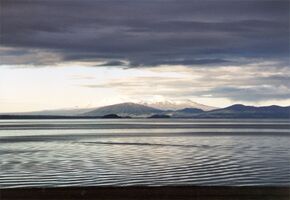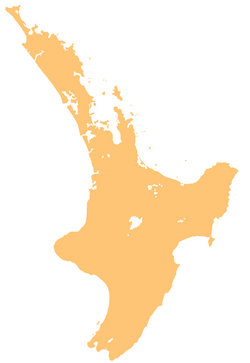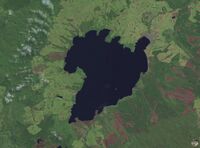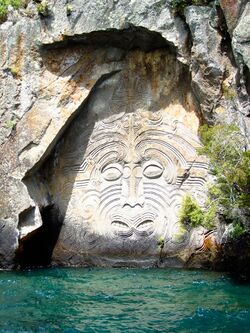Lake Taupo
Topic: Earth
 From HandWiki - Reading time: 7 min
From HandWiki - Reading time: 7 min
| Lake Taupo | |
|---|---|
| Taupō-nui-a-Tia (Māori) | |
 | |
| Location | Taupo District, Waikato region, North Island |
| Coordinates | [ ⚑ ] : 38°48′25″S 175°54′28″E / 38.80694°S 175.90778°E |
| Type | Crater lake, oligotrophic |
| Etymology | From Māori, Taupō-nui-a-Tia. Literally, “great cloak of Tia” |
| rivers, streams, precipitation">Primary inflows | Waitahanui River, Tongariro River, Tauranga Taupo River |
| rivers, streams, evaporation">Primary outflows | Waikato River |
| Catchment area | 3,487 km2 (1,346 sq mi) |
| Basin countries | New Zealand |
| Max. length | 46 km (29 mi) |
| Max. width | 33 km (21 mi) |
| Surface area | 616 km2 (238 sq mi) |
| Average depth | 110 m (360 ft) |
| Max. depth | 186 m (610 ft) |
| Water volume | 59 km3 (14 cu mi) |
| Residence time | 10.5 years |
| Shore length1 | 193 km (120 mi) |
| Surface elevation | 356 m (1,168 ft)[1] |
| 1 Shore length is not a well-defined measure. | |
Lake Taupo, often spelled Taupō, is a lake in the North Island of New Zealand. It is in the caldera of the Taupo Volcano. The lake is the namesake of the town of Taupō, which sits on a bay in the lake's north-eastern shore. With a surface area of 616 square kilometres (238 sq mi), it is the largest lake by surface area in New Zealand, and the second largest freshwater lake by surface area in geopolitical Oceania after Lake Murray in Papua New Guinea. Motutaiko Island lies in the south east area of the lake.
Lake Taupo has a perimeter of approximately 193 kilometres and a maximum depth of 186 metres. It is drained by the Waikato River (New Zealand's longest river), and its main tributaries are the Waitahanui River, the Tongariro River, and the Tauranga Taupo River. It is a noted trout fishery with stocks of introduced brown and rainbow trout.
The level of the lake is controlled by Mercury Energy, the owner of the eight hydroelectric dams on the Waikato River downstream of Lake Taupo, using gates built in 1940–41. The gates are used to reduce flooding, conserve water and ensure a minimum flow of 50 m3/s (1,800 cu ft/s) in the Waikato River. The resource consent allows the level of the lake to be varied between 355.85 and 357.25 metres (1,167.5 and 1,172.1 ft) above sea level.[2]
Lake formation and volcanism
Lake Taupo is in a caldera created by a supervolcanic eruption which occurred approximately 26,500 years ago. According to geological records, the volcano has erupted 28 times in the last 27,000 years. It has ejected mostly rhyolitic lava, although Mount Tauhara formed from dacitic lava.
Taupo has been active for 300,000 years with a very large event known as the Oruanui eruption occurring 26,500 years ago. It was the world's largest known eruption over the past 70,000 years, ejecting 1170 cubic kilometres of material and causing several hundred square kilometres of surrounding land to collapse and form the caldera. The caldera later filled with water to form Lake Taupo, eventually overflowing to cause a huge outburst flood.[3]
Several later eruptions occurred over the millennia before the most recent major eruption, which is traditionally dated as about 181 CE from Greenland ice-core records. Tree ring data from two studies suggests a later date of 232 CE ± 5.[4] Known as the Hatepe eruption, it is believed to have ejected 100 cubic kilometres of material, of which 30 cubic kilometres was ejected in a few minutes. This was one of the most violent eruptions in the last 5000 years (alongside the Minoan eruption in the 2nd millennium BCE, the Tianchi eruption of Baekdu around 1000 CE and the 1815 eruption of Tambora), with a Volcanic Explosivity Index rating of 7; and there appears to be a correlation, to within a few years, of a year in which the sky was red over Rome and China . The eruption devastated much of the North Island and further expanded the lake. The area was uninhabited by humans at the time of the eruption since New Zealand was not settled by the Māori until about 1280. Possible climatic effects of the eruption would have been concentrated on the southern hemisphere due to the southerly position of Lake Taupo.[5] Taupo's last known eruption occurred around 30 years later, with lava dome extrusion forming the Horomatangi Reefs, but that eruption was much smaller than the 180 CE eruption.
Underwater hydrothermal activity continues near the Horomatangi vent,[6] and nearby geothermal fields with associated hot springs are found north and south of the lake, for example at Rotokawa and Turangi. These springs are the site of occurrence of certain extremophile micro-organisms, that are capable of surviving in extremely hot environments.[7]
The volcano is currently considered to be dormant rather than extinct because of moderate fumarole activity and hot springs along the shores of the lake.
Biota
Much of the watershed of Lake Taupo is a beech and podocarp forest with associate understory ferns being Blechnum filiforme, Asplenium flaccidum, Doodia media, Hymenophyllum demissum, Microsorum pustulatum and Dendroconche scandens, and some prominent associate shrubs being Olearia ranii and Alseuosmia quercifolia.[8]
Native faunal species in the lake include northern koura or crayfish (Paranephrops planifrons) and kokopu or whitebait (Galaxias species). The lake is noted for stocks of brown trout (Salmo trutta) and rainbow trout (Oncorhynchus mykiss), introduced from Europe and California respectively in the late nineteenth century. There has also been a subsequent introduction of smelt (Retropinnidae species) as a food for the trout.
A community of sponges and associated invertebrates live around the underwater geothermal vents.[6]
Tourism
Tourism is a major component of Taupo's commercial sector. The busiest time for the industry is the high summer season around Christmas and New Year.
The lake area has a temperate climate. Daily maximum temperatures recorded for Taupo range from an average of 23.3 °C in January and February to 11.2 °C in July,[9] while the nighttime minimum temperatures range from 11.6 °C in February down to 2.2 °C in July.[10] Rain falls in all seasons but is greatest in winter and spring, from June to December.[11]
Taupo hosts the Lake Taupo Cycle Challenge, a cycling tour around the lake which can take anywhere between four and ten hours. Hundreds of volunteers from the Taupo township are involved in the event. Skydiving is a popular local sport and tourist attraction. Taupo also hosts the Kellogg's Ironman event.
Crossing the 40.2 km length of the lake is a challenge for open-water swimmers. In 2020, Michael Wells from Darwin, Australia, was the first to breaststroke across the lake.[12]
Māori rock carving
On the north-west side of Lake Taupo on the cliffs of Mine Bay, there are Māori rock carvings created in the late 1970s by Matahi Whakataka-Brightwell and John Randall. Carved in the likeness of Ngatoroirangi, a navigator who guided the Tuwharetoa and Te Arawa tribes to the Taupo area over a thousand years ago according to Māori legend.[13] The 10-metre-high carving is intended to protect Lake Taupo from volcanic activities underneath. The cliff has become a popular tourist destination with hundreds of boats and yachts visiting the spot yearly.
Māori tribes
Lake Taupo is a taonga (treasure or something special to the person) of Ngati Tuwharetoa from the Te Arawa waka. Ngāti Tūwharetoa still owns the bed of the lake and its tributaries. They grant the public free access for recreational use.[14]
See also
- List of lakes in New Zealand
- List of volcanoes in New Zealand
- Taupo Volcanic Zone
References
- ↑ "Lake levels". Te Tari Taiwhenua | Department of Internal Affairs. https://www.dia.govt.nz/Lake-Taupo-Lake-Levels.
- ↑ Opus International Consultants Limited (27 February 2009). "Lake Level History". https://emidatasets.blob.core.windows.net/publicdata/Datasets/Environment/_AdditionalInformation/ArchivedDatasets/20100630_HydrologicalData/20090331_Lake_level_history/20090331_Lake_level_history_report.pdf.
- ↑ Manville, Vern & Wilson, Colin J. N. (2004). "The 26.5 ka Oruanui eruption, New Zealand: a review of the roles of volcanism and climate in the post-eruptive sedimentary response". New Zealand Journal of Geology & Geophysics 47 (3): 525–547. doi:10.1080/00288306.2004.9515074.
- ↑ "Revised calendar date for the Taupo eruption derived by 14C wiggle-matching using a New Zealand kauri 14C calibration data set". The Holocene 22 (4): 439–449. 2011. doi:10.1177/0959683611425551. Bibcode: 2012Holoc..22..439H.
- ↑ Climate, History and the Modern World, Lamb, H. (1995), Routledge
- ↑ 6.0 6.1 C. E. J. de Ronde, P. Stoffers, D. Garbe-Schönberg, B. W. Christenson, B. Jones, R. Manconi, P. R. L. Browne, K. Hissmann, R. Botz, B. W. Davy, M. Schmitt and C. N. Battershill (2002). "Discovery of active hydrothermal venting in Lake Taupo, New Zealand". Journal of Volcanology and Geothermal Research 115 (3–4): 257–275. doi:10.1016/S0377-0273(01)00332-8. Bibcode: 2002JVGR..115..257D.
- ↑ C.Michael Hogan. 2010. Extremophile. eds. E.Monosson and C.Cleveland. Encyclopedia of Earth. National Council for Science and the Environment, Washington DC
- ↑ C. Michael Hogan. 2009. Crown Fern: Blechnum discolor, Globaltwitcher.com, ed. N. Stromberg
- ↑ "Mean Daily Maximum Temperatures". NIWA. http://www.niwa.co.nz/sites/default/files/import/attachments/data_maxairtemp_space.prn.
- ↑ "Mean Daily Minimum Temperatures". NIWA. http://www.niwa.co.nz/sites/default/files/import/attachments/data_minairtemp_space.prn.
- ↑ "Mean Monthly Rainfall". NIWA. http://www.niwa.co.nz/sites/default/files/import/attachments/rain.prn.
- ↑ Byrne, Conor (2020-01-19). "'Exhaustion, exposure, hypothermia' all possible in Lake Taupo record swim" (in en-AU). https://www.abc.net.au/news/2020-01-19/darwin-man-breaststrokes-new-zealands-lake-taupo/11874820.
- ↑ "Maori Rock Carvings Lake Taupo". https://www.lovetaupo.com/en/see-do/art-culture/mine-bay-maori-rock-carvings/.
- ↑ "New deed of settlement for Lake Taupo" (Press release).
Further reading
- Ben G. Mason; David M. Pyle; Clive Oppenheimer (2004). "The size and frequency of the largest explosive eruptions on Earth". Bulletin of Volcanology 66 (8): 735–748. doi:10.1007/s00445-004-0355-9. Bibcode: 2004BVol...66..735M.
- "Taupo". Smithsonian Institution. https://volcano.si.edu/volcano.cfm?vn=241070.
External links
- Great Lake Taupo Official Visitor Information Website
- Turangi and Lake Taupo Website
- Lake Taupo Webcam
- Lake Taupo at the Waikato Regional Council
- Lake Taupo area at the Department of Conservation
 KSF
KSF





